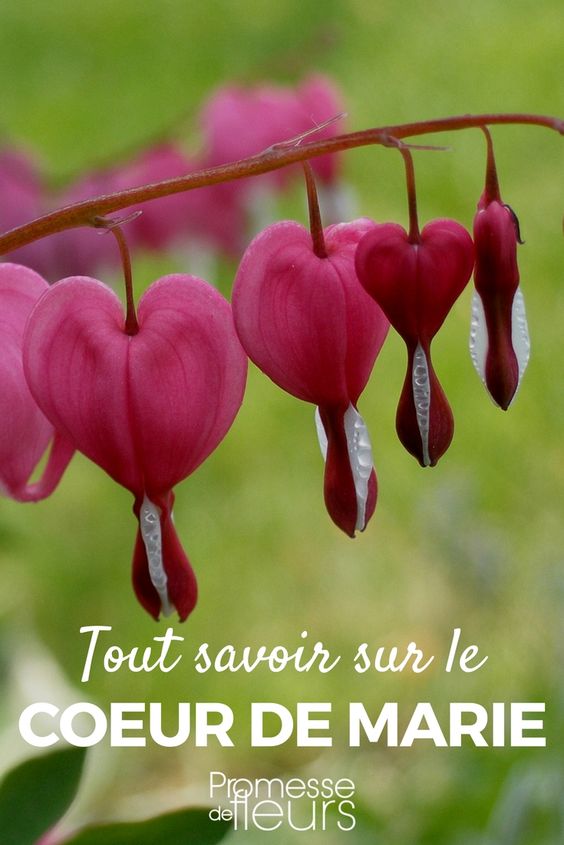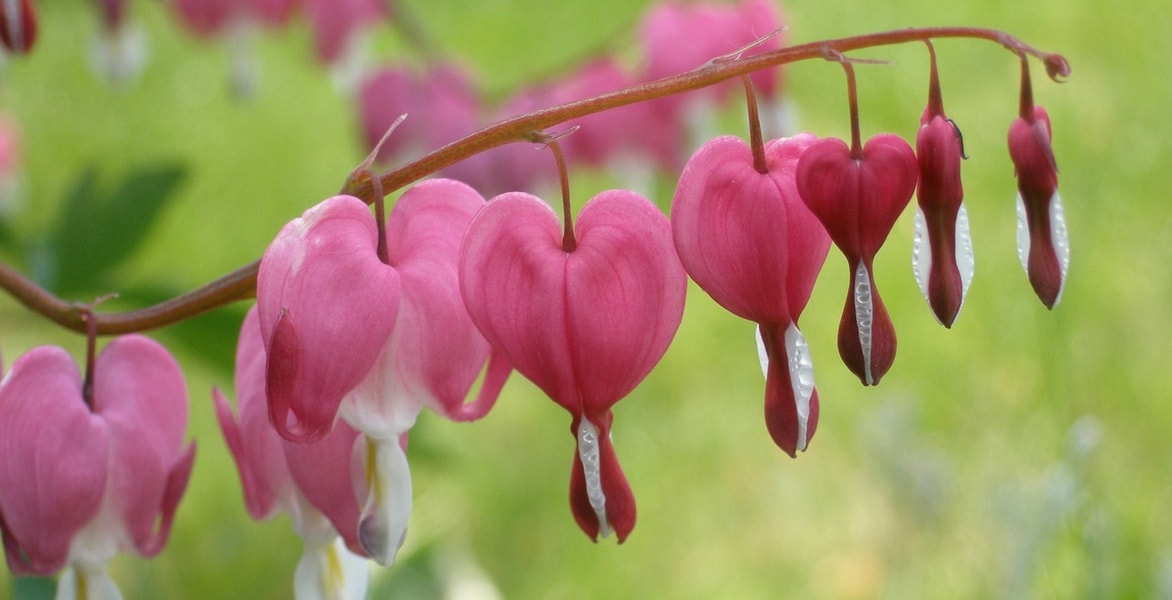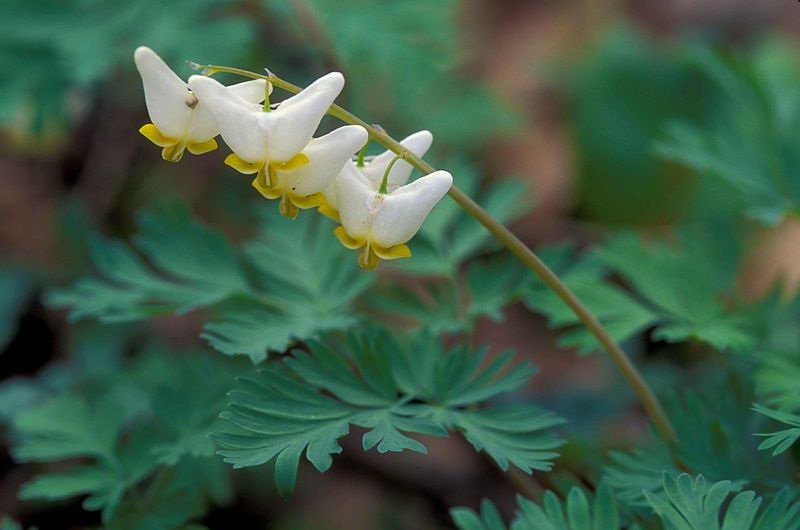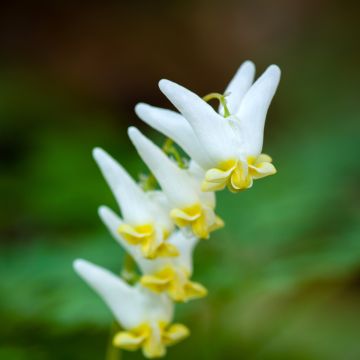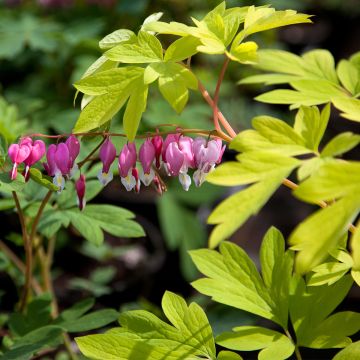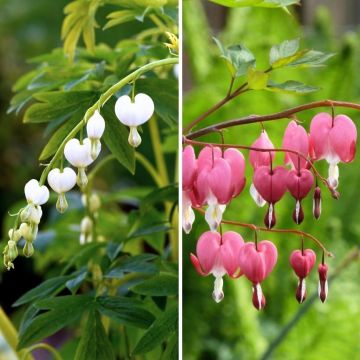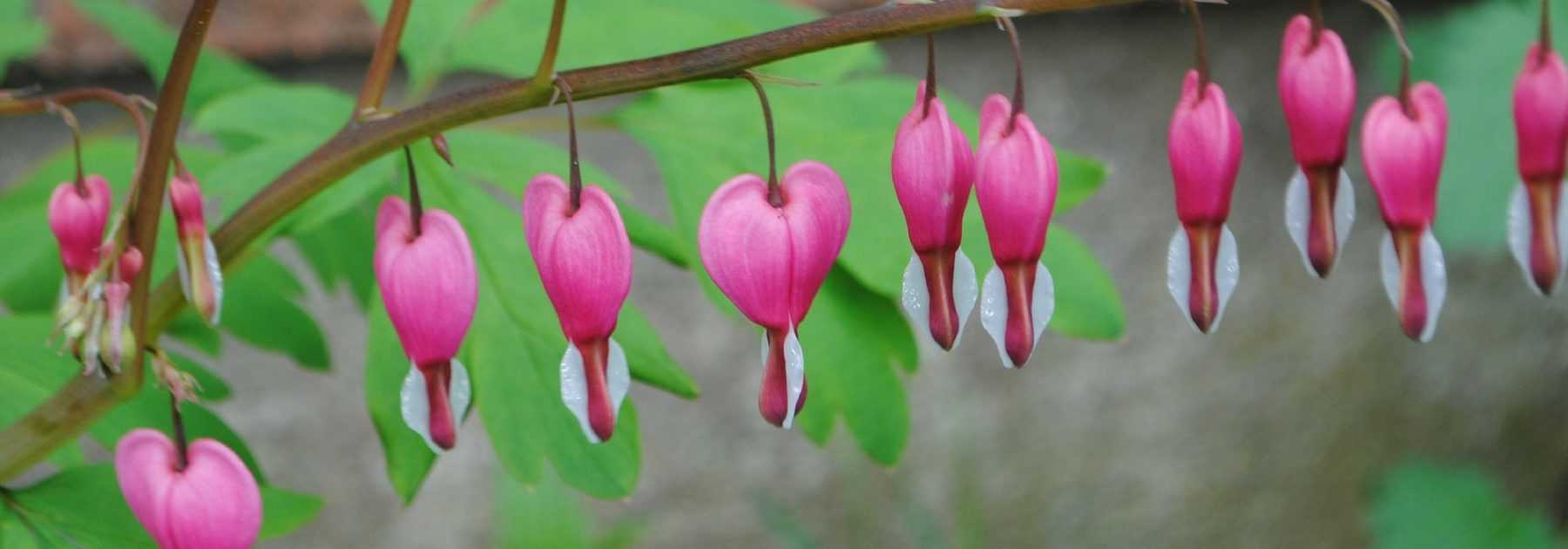
Bleeding Heart: Planting, Growing and Companion Planting
Contents
Bleeding Heart in a Few Words
- Bleeding Heart is one of the star plants for cool, shady gardens
- Its pretty white, pink or red heart-shaped flowers, delicately dangling from arched stems, appear abundantly from April to June.
- It boasts magnificent lush foliage with tender green or glaucous fern-like fronds
- Easy to grow and very cold-hardy, it only fears two things: summer drought and winter waterlogging.
- Once well-established in moist soil, it requires very little care
- A classic in cottage gardens and English mixed borders, it’s our favourite spring plant!
Our expert's word
The Bleeding Heart, also known as Dicentra, now classified under the name Lamprocapnos spectabilis, is a perennial plant with luxuriant, finely cut foliage in soft green or bluish-grey tones, notable for its abundant flowering. Its flowers are among the most graceful of spring blooms. While Dicentra spectabilis is the most iconic, Dicentra formosa and Dicentra eximia are two beautiful ground-cover species whose delicately cut and airy foliage resembles that of ferns or chervil.
Its pendulous flowers, shaped like tiny white, pink, or red hearts, bring lightness and charm to shaded gardens from April to June.
Introduced into ornamental gardens long ago, it has endured through generations of gardeners without losing its appeal. Its remarkable simplicity makes it indispensable in cottage gardens and English-style mixed borders, where it adds freshness and elegance. Delicate yet opulent, it is one of the cornerstones of shade gardens, white gardens, and English cottage gardens, often featured in romantic white-and-pink combinations with other perennials.
Hardy and easy to grow, this woodland beauty thrives in beds beneath large trees, along pathways, or in pots on shaded terraces and balconies.
It flourishes in the company of vigorous perennials that can take over later in the season and aren’t bothered by competition from tree or shrub roots. The Bleeding Heart pairs beautifully with ferns and hostas, creating lush displays. It also complements spring bulbs like Tulips, Grape Hyacinths, or Hyacinths, and blends well with ground-covering perennials such as Euphorbia cyparissias, Siberian Bugloss, Heucheras, and Foamflowers.
With its charm, resilience, and the unique beauty of its flowers and foliage—whether in a garden or not—the Bleeding Heart is a delightful, fuss-free plant that is sure to win you over.
Description and botany
Botanical data
- Latin name Dicentra spectabilis
- Family Papaveraceae (Fumariaceae)
- Common name Bleeding Heart, Lady's Locket
- Flowering April to June
- Height 20 cm to 60 cm for most common species, up to 3 m for D. scandens, a climbing variety
- Exposure sun, partial shade
- Soil type heathland (acidic), neutral
- Hardiness Hardy to -15°C but sensitive to late frosts
Dicentra spectabilis, commonly known as “Bleeding Heart”, “Lady’s Locket” or “Dutchman’s Breeches”, is native to North America and Asia, and can also be found in Siberia. In its natural habitat, this plant thrives in moist environments and mountainous forests, forming large clumps with finely divided foliage. In France and Europe, it grows at altitudes up to 1800 metres.
It belongs to the extensive Papaveraceae family (formerly Fumariaceae), which includes nearly 200 species of mostly herbaceous plants. The Bleeding Heart is related to poppies, fumitory and celandine, sharing their attractive grey-green, finely divided foliage. In Greek, Dicentra means “two spurs”, referring to the distinctive shape of its flowers with curiously reflexed outer petals.
The genus comprises over 20 perennial and annual species, including Dicentra spectabilis (the most common), Dicentra formosa and Dicentra eximia (two beautiful groundcover species), and even Dicentra scandens, a climbing variety reaching up to 3 m in height.
Bleeding Heart has a bushy, clump-forming habit. Heights vary by variety: between 30 and 60 cm tall, with similar spread, though climbing varieties can reach over a metre in height and width once established.
Bleeding Heart spreads easily through creeping rhizomes, tubers or thick fleshy roots, depending on the species. Groundcover varieties like Dicentra Formosa and D. eximia spread widely as their rhizomes weave between neighbouring plants. Some annual and biennial species also self-seed prolifically. Growth is moderately fast: it takes two to five years to reach full maturity and form a dense clump. Once established, it can live for decades if left undisturbed. It dislikes being moved as its brittle rhizomes are fragile.
Bleeding Heart produces exceptionally distinctive flowers, remarkable for their originality and delicacy. From its divided foliage emerge long, arching flower stems bearing panicles or clusters of 3 to 15 pendulous, heart-shaped flowers from April onwards. These unscented blooms are typically bright pink but can also be pure white, white tinged with mauve, purple, golden yellow or red depending on the species. The narrow, flattened flowers measure 3-5 cm tall and 2-3 cm wide. The species typically has irregular corollas with pink outer petals forming two-spurred hearts and white inner petals shaped like arrows. These tips may be white, pink, yellow or purple, creating bicoloured blooms – a unique floral architecture.
The remarkably abundant flowering begins in April-May, lasting three weeks to a month. Each fertilised flower produces a pod containing black, round seeds surrounded by white mucilage.
Some varieties’ foliage is as attractive as the flowers. While D. spectabilis has magnificent, lush leaves, the creeping varieties Dicentra formosa and D. eximia feature beautifully divided, decorative foliage. Finely cut, light and elegant, their leaves resemble ferns or chervil.
Deciduous, the foliage disappears in winter. In March-April, as temperatures rise, leaves emerge from the ground. The clump produces tall, fleshy shoots that become long, flower-laden stems by May-June. The upright, branching stems are usually bright green but may develop reddish or purple-pink tones depending on variety. Leaves display beautiful green shades ranging from bright to dark green, golden-green or blue-grey-green to silvery. The highly divided, pinnate or trilobate leaves measure 20-50 cm, creating a luxuriant effect as they spread, beautifully complementing the flowers.
After flowering, as summer arrives, the plant gradually enters dormancy: the foliage wilts and yellows, disappearing and leaving gaps in borders. Following its natural cycle, it rests to withstand drought, reappearing the following spring.
This woodland perennial prefers cool, shady conditions and dislikes direct sun. Plant it where it receives just a few hours of sunlight daily. It thrives in partial shade, with morning or evening sun, beneath deciduous trees that provide beneficial coolness. Deep shade may reduce flowering. Shelter it from spring winds that could damage fragile shoots. It tolerates sunny positions (except in southern regions) if soil remains moist and cool with good summer mulch.
A temperate climate plant, it dislikes summer drought or winter waterlogging. Tolerant of various soils, Dicentra spectabilis flourishes in light, humus-rich, well-drained soil that’s neutral to acidic, moist to dry in summer.
Despite their delicate appearance, these are not fragile plants. This hardy, vigorous perennial can be grown throughout the UK. Very frost-resistant, it withstands temperatures down to -15°C, with some varieties surviving below -30°C. However, young foliage is vulnerable to late frosts: early spring shoots may freeze, with others emerging later.
Ideal for challenging situations, it’s particularly suited to northern gardens, thriving best in regions with cool summers.
Perfect for borders, rockeries, balconies and terraces. Avoid group planting as summer dormancy leaves unsightly gaps. Combine with ferns and hostas that fill the space. Underplant with spring bulbs like tulips, daffodils, cyclamen or carpets of lily-of-the-valley, forget-me-nots or periwinkle. Pair with other perennials tolerant of tree root competition, such as hardy fuchsias, purple bugle, Japanese anemones or foxgloves.
Bleeding Heart is highly disease-resistant but vulnerable to aphids, snails and slugs.
Botanical species
The Bleeding Heart has been a staple in ornamental gardens for a very long time. Originally, around twenty species of Dicentra were identified, but only eight are currently recognised, including Dicentra spectabilis (the most common), D. canadensis, D. cucullaria, Dicentra formosa and Dicentra eximia (two beautiful ground-cover species), as well as D. peregrina. Dicentra scandens is a climbing variety. The two South American species, Dicentra formosa and D. eximia, are nearly identical and often confused.
The main selection criteria are flower colour and foliage hue. The varying heights between species can also influence the choice.
- Dicentra spectabilis: This is the most well-known and widely cultivated species in gardens. This tall perennial, with fleshy roots, bears exquisite soft pink flowers with white tips, dangling from gracefully arched stems. They stand out against elegant, deeply cut, light green leaves measuring 15 to 40 cm in length.
- Dicentra eximia: A rhizomatous perennial that forms beautiful, spreading clumps of grey-green leaves, finely divided like chervil or fern foliage. Slender panicles or drooping racemes carry pink, magenta-pink, or white flowers. Its blooms are longer and more elegant than those of D. formosa, with which it is often confused.
- Dicentra formosa: This widely spreading rhizomatous plant has green leaves with a bluish underside, creating a lovely contrast with its pink flower clusters that fade to near-white with age. It spreads easily, forming extensive colonies and weaving between other plants. It tolerates hot, humid summers less well than D. eximia.
- Dicentra scandens: A climbing, twining perennial that can scale sheltered walls and fences, reaching up to 3 metres in height. Its medium-green, deeply cut foliage contrasts with bright yellow or white flowers, sometimes tinged with purple or pink at the tips.
- Dicentra cucullaria: While its blue-green, deeply divided foliage resembles other species, its flowers are distinct—triangular in shape, resembling hoods or aeroplane wings, white with yellow tips rather than small hearts. Unlike other species in the genus, it is ephemeral, quickly fading and disappearing after flowering. Rarely cultivated in our regions… yet utterly charming!
Main varieties
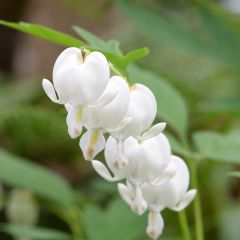
Dicentra spectabilis Alba
- Flowering time May to July
- Height at maturity 60 cm
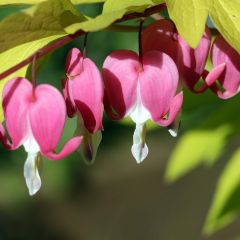
Dicentra spectabilis Goldheart
- Flowering time June, July
- Height at maturity 60 cm
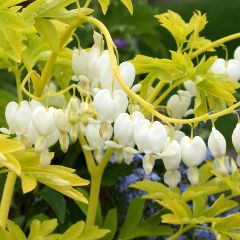
Dicentra spectabilis White Gold
- Flowering time June, July
- Height at maturity 60 cm
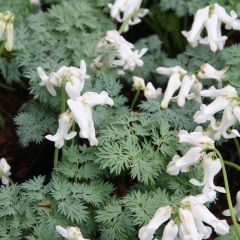
Dicentra Ivory Hearts
- Flowering time June to October
- Height at maturity 30 cm
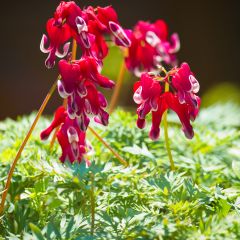
Dicentra Burning Hearts
- Flowering time June to October
- Height at maturity 40 cm

Dicentra formosa Bacchanal
- Flowering time June to October
- Height at maturity 30 cm
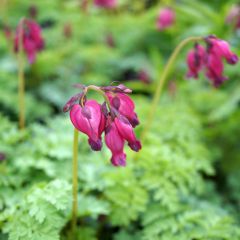
Dicentra King of Hearts
- Flowering time June, July
- Height at maturity 30 cm
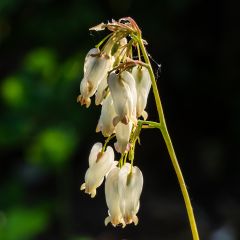
Dicentra formosa Aurora
- Flowering time June, July
- Height at maturity 25 cm
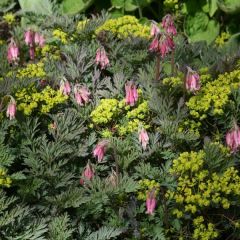
Dicentra Stuart Boothman
- Flowering time June to October
- Height at maturity 25 cm

Dicentra formosa Luxuriant
- Flowering time June to October
- Height at maturity 30 cm

Dicentra formosa Bacchanal
- Flowering time June to October
- Height at maturity 30 cm

Dicentra Stuart Boothman
- Flowering time June to October
- Height at maturity 25 cm

Dicentra Ivory Hearts
- Flowering time June to October
- Height at maturity 30 cm
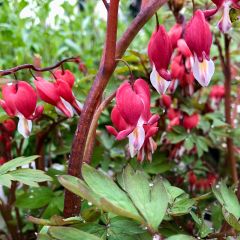
Dicentra spectabilis Valentine
- Flowering time June, July
- Height at maturity 35 cm
Discover other Dicentra - Bleeding Hearts
Planting
Where to Plant Bleeding Heart?
It can be planted throughout France. Very hardy, tolerating temperatures around -15°C, sometimes even lower in sheltered locations.
This is an easy plant to grow, provided it is planted in deep, fresh, humus-rich soil, preferably neutral or acidic and well-drained. It only fears excesses: water in winter and sun in summer. It thrives best in regions with cool summers.
It prefers partial shade, with exposure to sunlight for a few hours in the morning or late afternoon, or under dappled sunlight filtered by deciduous trees. Bleeding Heart has a great quality: it tolerates growing in root-filled soil, under trees, without hindering its development. It will tolerate a sunny position (except in southern regions) if the soil remains sufficiently moist and cool in summer. Good light is essential for flowering. However, we recommend planting it where it can express its full potential: protected from harsh, direct sun under the light shade of a tree, in cool soil and sheltered from prevailing cold winds.
Once established, avoid moving it, as it takes several years to reach full maturity.
Growing in pots is easy as long as watering is not neglected. Plant it in a pot at least 30 cm wide, in rich, humus-rich soil—it will thrive if the soil is never allowed to dry out… nor become waterlogged!
When to Plant?
Bleeding Heart can be planted in spring (around March) after the last frosts or in autumn (in September). Autumn planting encourages root establishment before winter.
How to Plant?
Once well established, Bleeding Heart requires little care. The secret to this elegant, vigorous perennial lies in the planting.
It needs light, well-draining, rich soil that remains cool in midsummer: if necessary, add well-rotted compost and a little sand for drainage. Some varieties do not tolerate clay soils.
For potted plants: soak the root balls in a basin of water until no more air bubbles escape. Both leaves and roots are fragile and easily damaged. When transplanting, do not disturb the root ball.
Dig a hole wide and deep enough. Space plants 40 cm apart. Plant in groups of 3 or 4 for a beautiful effect—no more. Avoid planting too many dicentras, as they leave an unsightly gap in summer. Pair them with ferns, hostas, Japanese anemones, corydalis, heucheras, or ophiopogons, which will take over in the border. Firm the soil. Keep the soil cool with mulch, especially in summer—this ensures prolonged flowering. Water regularly during the first summer to encourage root establishment. Protect from slugs. Then let it grow undisturbed—established plants prefer not to be moved.
To learn everything about planting this lovely perennial, check out our guide: “Bleeding Heart: Planting Success”
Maintenance and Pruning
Bleeding Hearts are not very demanding and require little maintenance.
During the flowering period, you can remove faded flowers as they appear to stimulate the growth of new blooms.
No pruning is necessary. After flowering, the plant will gradually enter dormancy, and the foliage will turn yellow. You can either leave it in place or simply cut it back to ground level during the summer to remove the unsightly faded stems.
In summer, the soil should remain moist. Mulching around the base helps retain moisture and promotes flowering, especially in hotter regions. Mulching can also be beneficial at the end of winter to protect against late frosts, to which young shoots are very sensitive. You can apply fertiliser at the end of spring.
Bleeding Hearts are highly resistant to diseases and pests. However, their young shoots may be vulnerable to aphids and gastropods. Fern manure can help deter snails and slugs.
Potted plants can be enriched with compost each year.
Propagation
The plant can be propagated by sowing seeds, or by taking stem or root cuttings, an alternative method best carried out in winter.
Sowing
Homegrown seedlings may sometimes be inconsistent, and the colours can differ from the parent plant. Root or stem cuttings are more reliable and help preserve the original hues. These perennials are relatively easy to grow from seed. Sow in autumn using fresh seeds from the same year before they dry out, ideally just after removing them from their pods. Sow under a cold frame in a sandy mix. Plant the seeds 6mm deep. Germination takes about 2 months. Transplant the seedlings once they are well-established, when they reach 5cm in height.
Division
Clump division is possible but tricky and should be done when the plant is dormant, preferably in summer after flowering or in autumn—though we do not recommend it. Bleeding Hearts dislike having their fragile rhizomes disturbed, and the risk of damage is high.
Root cuttings
Root cuttings should be taken in winter, working carefully to avoid damaging the plant’s delicate, fleshy roots. The parent plant must be lifted entirely from the ground—use a garden fork to loosen the root ball. Take care not to break the thick roots. Using secateurs, take an 8-10cm section of a healthy, vigorous root. Replant the parent immediately. Under a frost-free frame, plant the cuttings deeply and vertically in a light substrate made of compost and sand. Mist regularly to maintain reasonable moisture (but no more, as excess water may rot the roots). By April-May, stems will begin to emerge. Transplant each cutting into a pot and let them grow through the growing season. Avoid drought stress—ensure they are well-watered. In early autumn, transplant them directly into the ground.
Stem cuttings
Cut a healthy stem with leaves, about 15cm long, just below a node. Remove the lower leaves to prevent rotting. Place the cutting in a mix of garden soil, compost, and sand.
Association
With its profusion of flowers, Bleeding Heart ensures a very florid spring and early summer. It’s even inspiring for creating a natural-style garden, with plants requiring little care and maintenance.
Delicate and opulent, it thrives in various styles of flower beds, bringing elegance and originality. It is one of the centrepieces of shade gardens and English cottage gardens, where it appears in fresh, romantic white/pink combinations with other perennials.


With Daffodils and Tulips – Copyright – GAP Photos – Mark Bolton / In a white woodland setting with Masterwort and Foamflowers – Photo Credit GAP Elke Borkowski-092014
To intensify the colour in flower beds, red varieties can be paired with the bold or warm tones of a Hardy Geranium ‘Bob’s Blunder’, chocolate tulips, or the vivid red tubular flowers of Spigelia marilandica.
In the garden, avoid planting in groups—in summer, Dicentra leaves an unsightly gap in beds. It thrives in mixed plantings alongside vigorous perennials that aren’t bothered by competition from tree or shrub roots and will take over later. For a striking foliage effect, it’s often paired with ferns, sharing their finely divided leaves, or placed near glaucous-leaved plants like Hostas.
Pair it with the large yellow bell-shaped flowers of Uvularia grandiflora, Purple Bugle, Hellebores, or Foxgloves.
At the back of a shaded border, it works wonders with the colourful foliage of purple Heucheras, hardy geraniums, and alongside Masterworts, Columbines, Dame’s Rocket, or a silvery Lamium in magenta-pink or white.
For an elegant spring display, plant bulbs at its base: fresh-toned tulips, white daffodils, candelabra primroses. The glaucous hue of its leaves will enhance the pure blue of Siberian Bugloss and periwinkles or the purple of Pasqueflowers or Siberian Iris. It also forms a charming setting for lily-of-the-valley and miniature cyclamens, which require similar growing conditions.
In pots, it’s perfect as a standalone—its lush foliage and generous flowering will enliven a shaded terrace or balcony.
For a romantic or naturalistic look in containers, discover our successful pairing ideas and get inspired!
Useful resources
- The most beautiful Bleeding Heart varieties can be found here – discover them!
- Our expert, Michaël, discusses the Dicentra ‘King of Heart’, a remarkable new Bleeding Heart variety.
- Care guide: Choosing a Bleeding Heart
- Care guide: Bleeding Heart – The most beautiful varieties
Frequently asked questions
-
Are My Bleeding Hearts Turning Yellow in Summer – Is This Normal?
Yes, this is completely normal, it's a natural phenomenon. The foliage of Bleeding Heart gradually turns yellow and always withers in summer, around July-August, when flowering ends. The plant goes dormant, and its growth will restart the following spring.
-
It's the beginning of March and my Bleeding Heart isn't sprouting, why? (Note: "Cœur de Marie" is commonly known as "Bleeding Heart" (Lamprocapnos spectabilis) in British English. The translation maintains the gardening context while using the standard common name for UK/Irish audiences.)
It's still a bit early. The season remains cold and Bleeding Heart, although hardy, is slow to wake up. This is quite typical for this time of year. Next month, small shoots will begin to emerge from the soil. By May, you'll be able to enjoy its flowering.
-
My Bleeding Heart isn't thriving - when is the best time to move it? (Note: "Cœur de Marie" is commonly known as "Bleeding Heart" (Lamprocapnos spectabilis) in British English. The translation maintains the conversational gardening tone while using the correct common name for UK/Irish audiences.)
The Bleeding Heart dislikes being moved as it needs time to establish itself properly. However, if its current location doesn't seem suitable, it is indeed better to transplant it. It's preferable to wait until autumn to do so. You'll need to move it with great care, as the Bleeding Heart has very deep roots that are fragile and prone to breaking.
-
Should you cut back or prune Dicentra spectabilis?
There is no need to cut it back, pruning is unnecessary. After flowering, simply remove the faded stems that detract from its aesthetic appeal.
-
Can the Bleeding Heart be divided?
The plant does not tolerate disturbance to its fragile rhizomes well. We advise against dividing the clumps. Root cuttings are preferable and less risky.
- Subscribe!
- Contents
